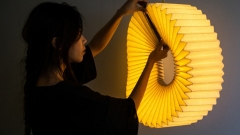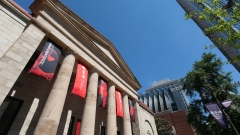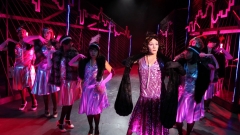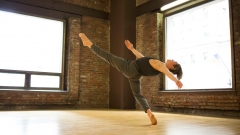Dance Alum Realizes Jasper Johns Costumes for Art Museum Performances
January 14, 2022
As the Philadelphia Museum of Art winds down its landmark retrospective Jasper Johns: Mind/Mirror, a series of Philadelphia Dance Company performances ran from Jan. 14 to 16, 2022, that underscored the artist's deep and abiding artistic connections to dance.
As the dancers moved through the museum's recently completed Williams Forum, they did so in costumes originally designed by Johns in the early 1970s and more recently realized by UArts alum Reid Bartelme MFA '21 (Dance) and his design partner, Harriet Jung. The duo operates the New York-based design studio Reid & Harriet.
Though Johns is widely known for his paintings, sculptures and prints, he also enjoyed a fruitful and inspiring artistic partnership with legendary choreographer Merce Cunningham. For more than a decade, Johns served as the artistic advisor for the Merce Cunningham Dance Company, and many of the compositional strategies he employed in his work echoed Cunningham's beautifully complex choreography. His engagement with performance continues to this day. The museum's event was staged in conjunction with Patricia Lent, a trustee and director of licensing for the Merce Cunningham Trust as well as a former dancer, and featured choreographic material from four Johns/Cunningham collaborations: "Canfield," "Landrover," "Un jour ou Deux" and "Exchange."
"Landrover" was the focus of Bartelme's charge, and the dancers wore the same costumes through all four works. Johns' original designs for the piece were leotards and tights in various solid colors to accompany what Cunningham envisioned as "people moving in different landscapes. American, perhaps in the sense that we move in our country—across varied spaces—with varied backgrounds."
For the original staging in the early 1970s, Bartelme said, the female performers wore leotards with nylon tights underneath them, and male performers wore leotards with tights over the top. Bartleme noted that though slight, the variations created different styles since Cunningham and his collaborators may not have been quite willing to challenge gender norms at the time. Later, however, unitards that covered the entire body with minimum seams became ubiquitous at Cunningham performances and formed the basis of Bartelme and Jung's reinterpretation.
"You can use the unitard to distinguish gender through whatever mode you want through neckline or sleeve length," Bartelme said. "But at the end of the day, it does blur the boundaries of gender more effectively than what the costumes previously were."
For their reinterpretation, Bartelme and Jung worked from archival photos that were gathered when the trust moved its costume archive to Minneapolis' Walker Arts Center. Bartelme said Johns' "Landrover" designs and their solid colors were a good fit for an event that features excerpts from multiple dances.
"You get to experience each person as an individual, but when dancers come together to perform duet material or group material, you get to experience those colors in different configurations," he said. "In the performance itself, you get the surprise of seeing various color combinations come to life through choreography."
In addition, costumes designed by Bartelme and Jung will accompany choreographer Pam Tanowitz's "Finally Unfinished (Solo for Melissa for Jasper)" at the museum later this month. Performed by Melissa Toogood, a former dancer for the Merce Cunningham Dance Company, the work playfully evokes "Walkaround Time," a dance Cunningham created in 1968 as an homage to Marcel Duchamp with a Johns-designed set.
For more information on upcoming museum performances, visit philamuseum.org/calendar.
Image by Julieanne Harris.





